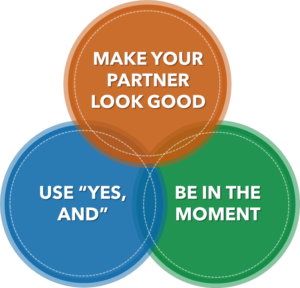Adopting Improv to Ace Instructional Design
 Last month, Sheree Galpert, an Applied Improv practitioner and trainer, shared fundamentals of improvisation in EnVision’s blog. Sheree introduced three principles of improvisation:
Last month, Sheree Galpert, an Applied Improv practitioner and trainer, shared fundamentals of improvisation in EnVision’s blog. Sheree introduced three principles of improvisation:
- Be in the moment
- Use “Yes, and”
- Make your partner look good
Sheree illustrated how instructional designers can leverage these techniques to be more effective in their work.
After reading Sheree’s post, I was pleased to realize that a recent project of EnVision’s incorporated each of the improvisation principles she shared with us last month. The project was a needs assessment and design of a management development course for a financial services client.
In our interactions with this client and others, I recognized that we do a lot of “being in the moment.” Our instructional designers listen carefully to what clients say, so they can understand their needs. Only then can we make appropriate recommendations and be responsive in our work.
“Yes, and?” For the needs assessment, we initially agreed to conduct one focus group with selected client employees. The client’s key stakeholder requested we run a second focus group with a different employee cohort to gain a broader sense of the organization’s needs. While we agreed this was a beneficial plan we essentially added a “yes, and” to our reply. “Yes,” we said, (after all, agility is one of EnVision’s values.) “And this changes the scope of work for the needs assessment, so the project will take a bit longer and cost x dollars more. Does that timeline work for you?” The client was fine with it, so something tells me this improv approach is useful!
Certainly, it is part of the trainer’s job to make the learner “look good,” as Sheree described. In the needs assessment and design phase of this project, EnVision’s instructional designers also helped the client’s stakeholders to look good.
We acknowledge that the SME and other stakeholders are the content experts. EnVision’s consulting expertise and the client stakeholders’ content expertise complement each other. We ask targeted questions of the SME and other stakeholders and guide the instructional design process, which ultimately results in a more effective learning solution for our client’s organization. Content expertise partnered with solid instructional design skills help to make our client stakeholders “look good.”
As instructional designers, we think on our feet, similarly to how an improvisational artist would. These improv techniques help us to be more responsive to and collaborative with the project’s stakeholders. And this furthers our relationships with our clients, which we value the most in our work.
Want to learn more about how to use Applied Improv? The Improv Lab, run by Sheree Galpert, is open to trainers/facilitators in the Boston area on the second Saturday of every month from 2-3:30 ET. In person (outside) through summer; starting in the fall, it will be online and open to people who are anywhere! Private message Sheree via LinkedIn.


